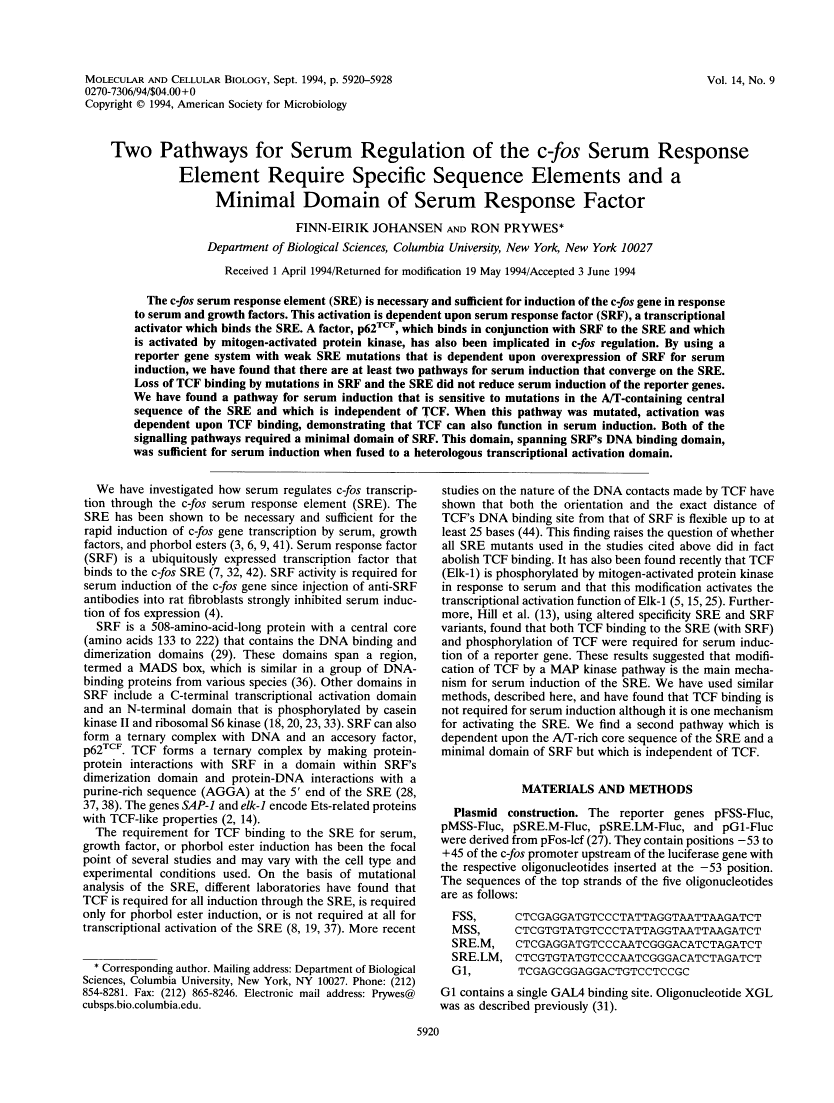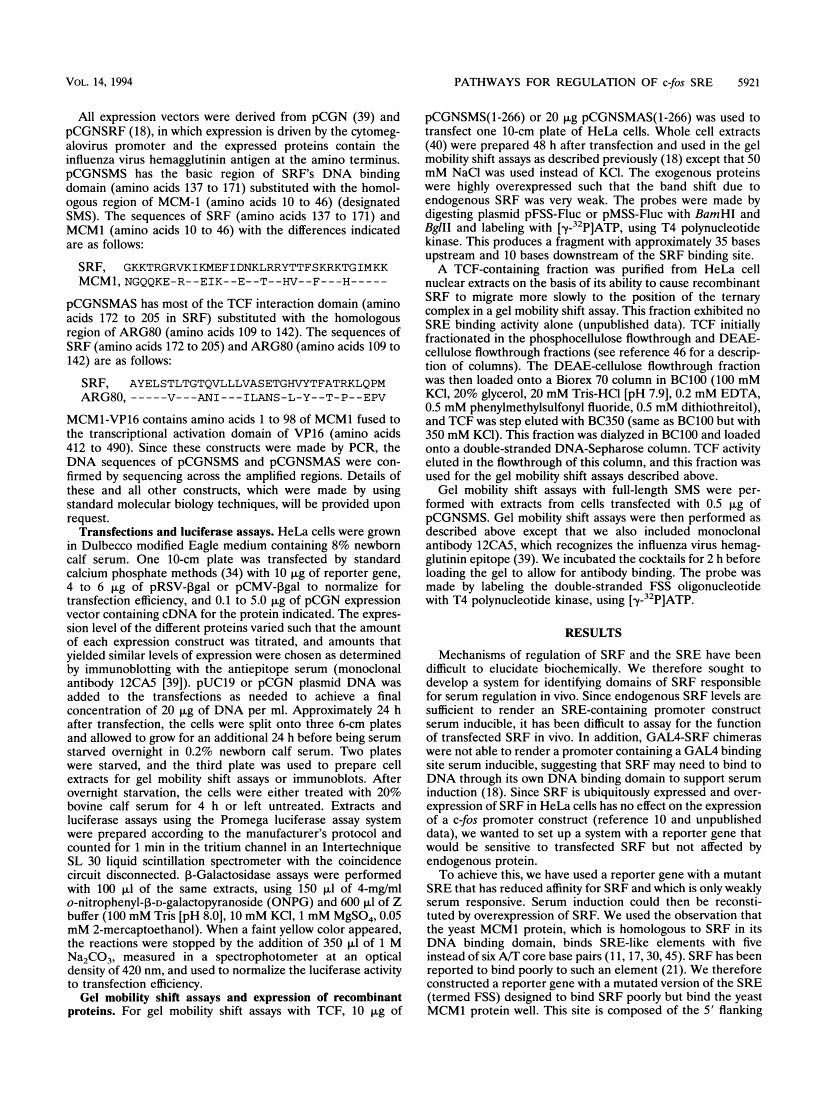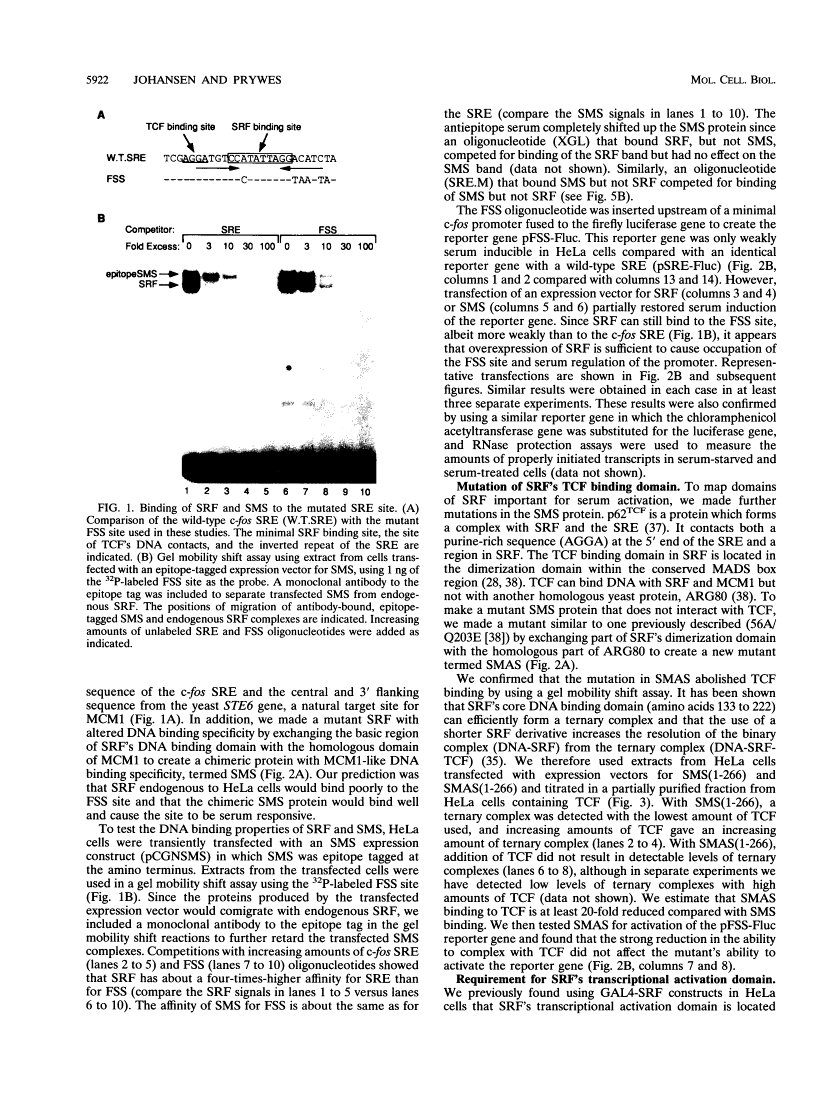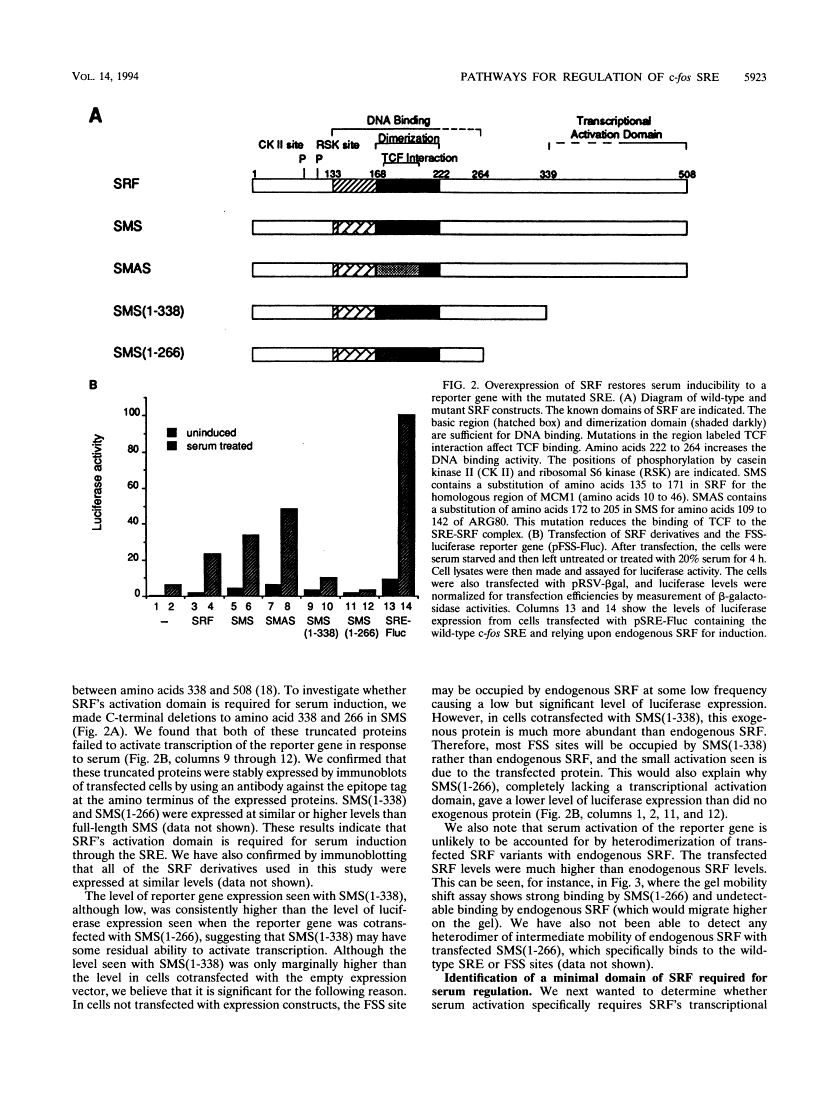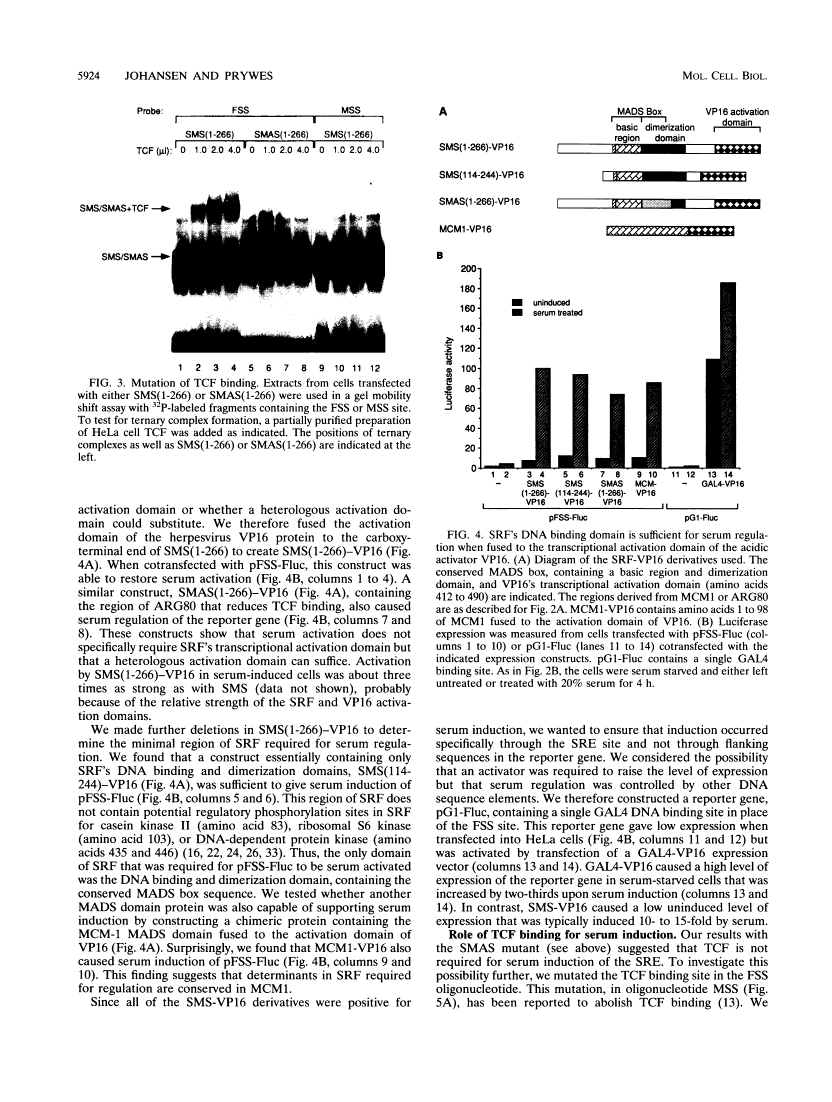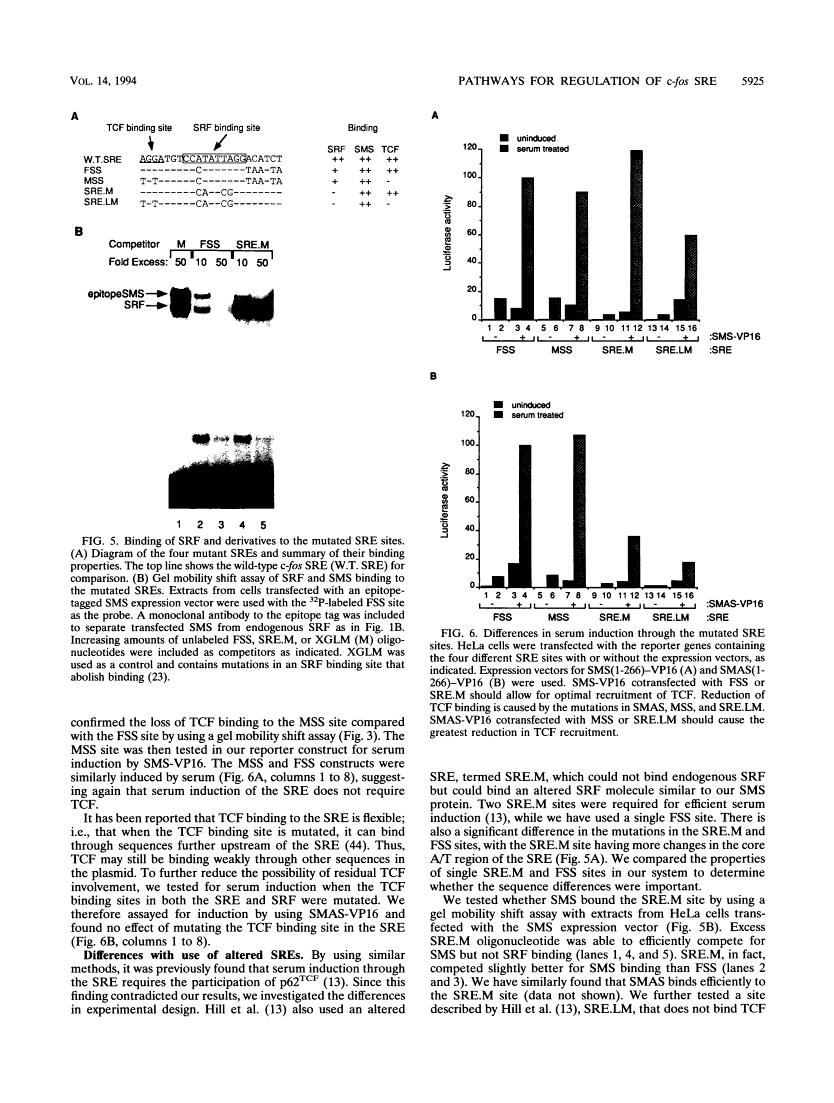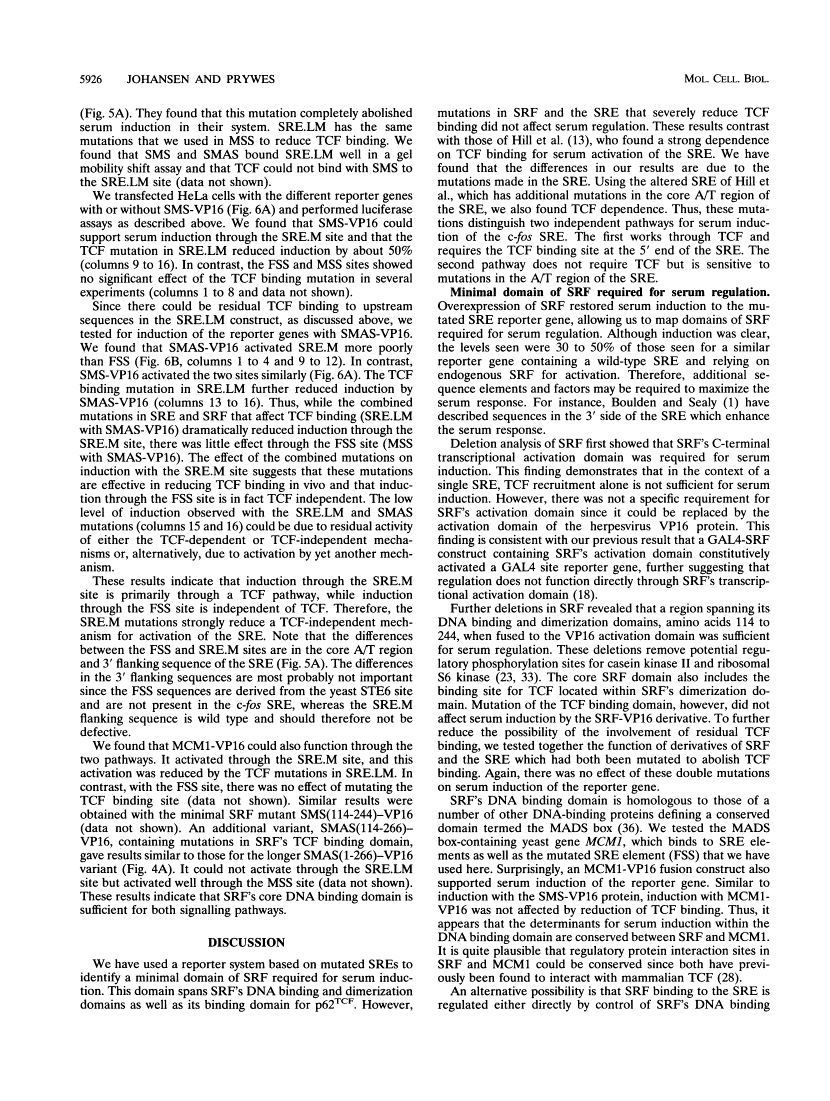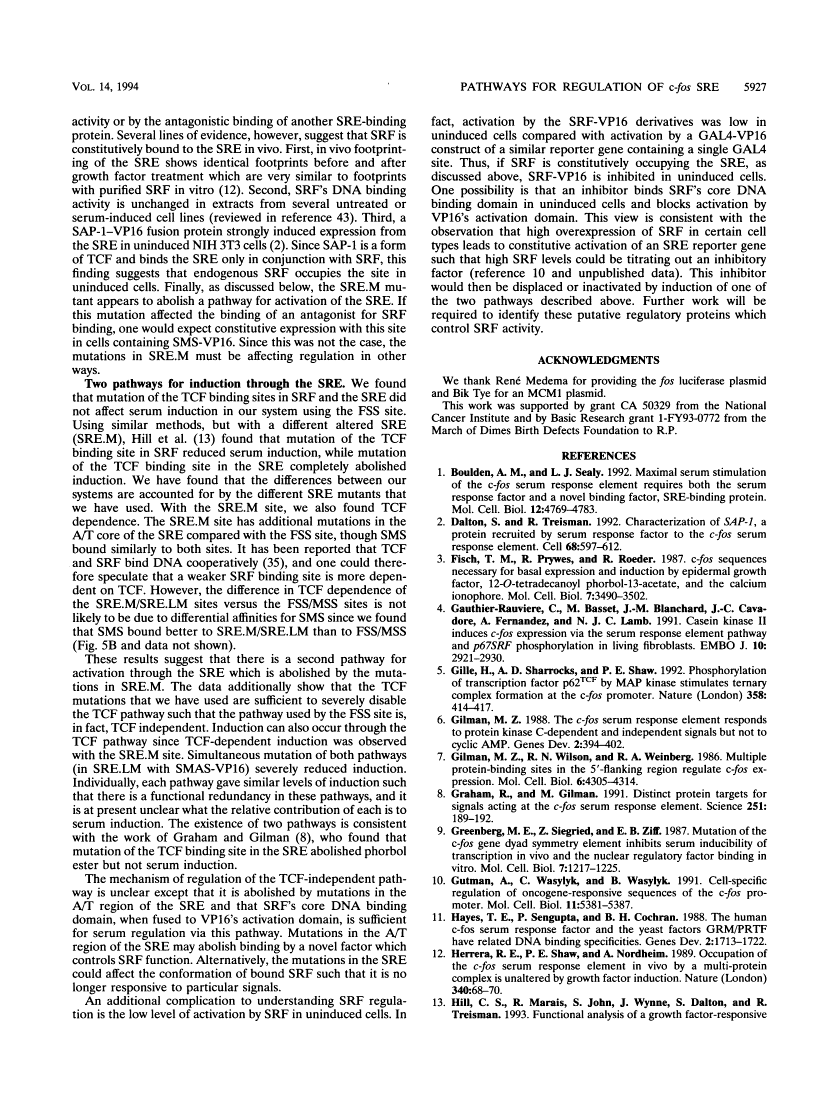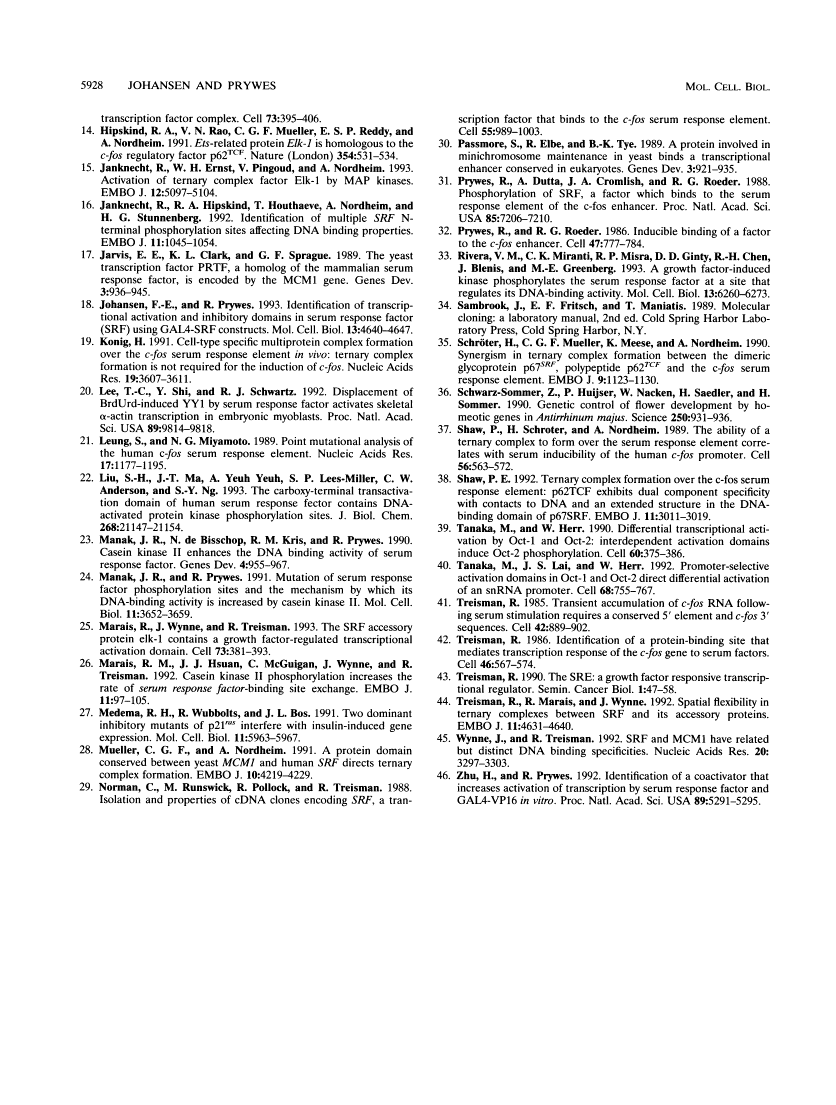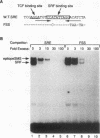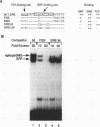Abstract
Free full text

Two pathways for serum regulation of the c-fos serum response element require specific sequence elements and a minimal domain of serum response factor.
Abstract
The c-fos serum response element (SRE) is necessary and sufficient for induction of the c-fos gene in response to serum and growth factors. This activation is dependent upon serum response factor (SRF), a transcriptional activator which binds the SRE. A factor, p62TCF, which binds in conjunction with SRF to the SRE and which is activated by mitogen-activated protein kinase, has also been implicated in c-fos regulation. By using a reporter gene system with weak SRE mutations that is dependent upon overexpression of SRF for serum induction, we have found that there are at least two pathways for serum induction that converge on the SRE. Loss of TCF binding by mutations in SRF and the SRE did not reduce serum induction of the reporter genes. We have found a pathway for serum induction that is sensitive to mutations in the A/T-containing central sequence of the SRE and which is independent of TCF. When this pathway was mutated, activation was dependent upon TCF binding, demonstrating that TCF can also function in serum induction. Both of the signalling pathways required a minimal domain of SRF. This domain, spanning SRF's DNA binding domain, was sufficient for serum induction when fused to a heterologous transcriptional activation domain.
Full text
Full text is available as a scanned copy of the original print version. Get a printable copy (PDF file) of the complete article (2.1M), or click on a page image below to browse page by page. Links to PubMed are also available for Selected References.
Images in this article
Selected References
These references are in PubMed. This may not be the complete list of references from this article.
- Boulden AM, Sealy LJ. Maximal serum stimulation of the c-fos serum response element requires both the serum response factor and a novel binding factor, SRE-binding protein. Mol Cell Biol. 1992 Oct;12(10):4769–4783. [Europe PMC free article] [Abstract] [Google Scholar]
- Dalton S, Treisman R. Characterization of SAP-1, a protein recruited by serum response factor to the c-fos serum response element. Cell. 1992 Feb 7;68(3):597–612. [Abstract] [Google Scholar]
- Fisch TM, Prywes R, Roeder RG. c-fos sequence necessary for basal expression and induction by epidermal growth factor, 12-O-tetradecanoyl phorbol-13-acetate and the calcium ionophore. Mol Cell Biol. 1987 Oct;7(10):3490–3502. [Europe PMC free article] [Abstract] [Google Scholar]
- Gauthier-Rouvière C, Basset M, Blanchard JM, Cavadore JC, Fernandez A, Lamb NJ. Casein kinase II induces c-fos expression via the serum response element pathway and p67SRF phosphorylation in living fibroblasts. EMBO J. 1991 Oct;10(10):2921–2930. [Europe PMC free article] [Abstract] [Google Scholar]
- Gille H, Sharrocks AD, Shaw PE. Phosphorylation of transcription factor p62TCF by MAP kinase stimulates ternary complex formation at c-fos promoter. Nature. 1992 Jul 30;358(6385):414–417. [Abstract] [Google Scholar]
- Gilman MZ. The c-fos serum response element responds to protein kinase C-dependent and -independent signals but not to cyclic AMP. Genes Dev. 1988 Apr;2(4):394–402. [Abstract] [Google Scholar]
- Gilman MZ, Wilson RN, Weinberg RA. Multiple protein-binding sites in the 5'-flanking region regulate c-fos expression. Mol Cell Biol. 1986 Dec;6(12):4305–4316. [Europe PMC free article] [Abstract] [Google Scholar]
- Graham R, Gilman M. Distinct protein targets for signals acting at the c-fos serum response element. Science. 1991 Jan 11;251(4990):189–192. [Abstract] [Google Scholar]
- Greenberg ME, Siegfried Z, Ziff EB. Mutation of the c-fos gene dyad symmetry element inhibits serum inducibility of transcription in vivo and the nuclear regulatory factor binding in vitro. Mol Cell Biol. 1987 Mar;7(3):1217–1225. [Europe PMC free article] [Abstract] [Google Scholar]
- Gutman A, Wasylyk C, Wasylyk B. Cell-specific regulation of oncogene-responsive sequences of the c-fos promoter. Mol Cell Biol. 1991 Oct;11(10):5381–5387. [Europe PMC free article] [Abstract] [Google Scholar]
- Hayes TE, Sengupta P, Cochran BH. The human c-fos serum response factor and the yeast factors GRM/PRTF have related DNA-binding specificities. Genes Dev. 1988 Dec;2(12B):1713–1722. [Abstract] [Google Scholar]
- Herrera RE, Shaw PE, Nordheim A. Occupation of the c-fos serum response element in vivo by a multi-protein complex is unaltered by growth factor induction. Nature. 1989 Jul 6;340(6228):68–70. [Abstract] [Google Scholar]
- Hill CS, Marais R, John S, Wynne J, Dalton S, Treisman R. Functional analysis of a growth factor-responsive transcription factor complex. Cell. 1993 Apr 23;73(2):395–406. [Abstract] [Google Scholar]
- Hipskind RA, Rao VN, Mueller CG, Reddy ES, Nordheim A. Ets-related protein Elk-1 is homologous to the c-fos regulatory factor p62TCF. Nature. 1991 Dec 19;354(6354):531–534. [Abstract] [Google Scholar]
- Janknecht R, Ernst WH, Pingoud V, Nordheim A. Activation of ternary complex factor Elk-1 by MAP kinases. EMBO J. 1993 Dec 15;12(13):5097–5104. [Europe PMC free article] [Abstract] [Google Scholar]
- Janknecht R, Hipskind RA, Houthaeve T, Nordheim A, Stunnenberg HG. Identification of multiple SRF N-terminal phosphorylation sites affecting DNA binding properties. EMBO J. 1992 Mar;11(3):1045–1054. [Europe PMC free article] [Abstract] [Google Scholar]
- Jarvis EE, Clark KL, Sprague GF., Jr The yeast transcription activator PRTF, a homolog of the mammalian serum response factor, is encoded by the MCM1 gene. Genes Dev. 1989 Jul;3(7):936–945. [Abstract] [Google Scholar]
- Johansen FE, Prywes R. Identification of transcriptional activation and inhibitory domains in serum response factor (SRF) by using GAL4-SRF constructs. Mol Cell Biol. 1993 Aug;13(8):4640–4647. [Europe PMC free article] [Abstract] [Google Scholar]
- König H. Cell-type specific multiprotein complex formation over the c-fos serum response element in vivo: ternary complex formation is not required for the induction of c-fos. Nucleic Acids Res. 1991 Jul 11;19(13):3607–3611. [Europe PMC free article] [Abstract] [Google Scholar]
- Lee TC, Shi Y, Schwartz RJ. Displacement of BrdUrd-induced YY1 by serum response factor activates skeletal alpha-actin transcription in embryonic myoblasts. Proc Natl Acad Sci U S A. 1992 Oct 15;89(20):9814–9818. [Europe PMC free article] [Abstract] [Google Scholar]
- Leung S, Miyamoto NG. Point mutational analysis of the human c-fos serum response factor binding site. Nucleic Acids Res. 1989 Feb 11;17(3):1177–1195. [Europe PMC free article] [Abstract] [Google Scholar]
- Liu SH, Ma JT, Yueh AY, Lees-Miller SP, Anderson CW, Ng SY. The carboxyl-terminal transactivation domain of human serum response factor contains DNA-activated protein kinase phosphorylation sites. J Biol Chem. 1993 Oct 5;268(28):21147–21154. [Abstract] [Google Scholar]
- Manak JR, de Bisschop N, Kris RM, Prywes R. Casein kinase II enhances the DNA binding activity of serum response factor. Genes Dev. 1990 Jun;4(6):955–967. [Abstract] [Google Scholar]
- Manak JR, Prywes R. Mutation of serum response factor phosphorylation sites and the mechanism by which its DNA-binding activity is increased by casein kinase II. Mol Cell Biol. 1991 Jul;11(7):3652–3659. [Europe PMC free article] [Abstract] [Google Scholar]
- Marais R, Wynne J, Treisman R. The SRF accessory protein Elk-1 contains a growth factor-regulated transcriptional activation domain. Cell. 1993 Apr 23;73(2):381–393. [Abstract] [Google Scholar]
- Marais RM, Hsuan JJ, McGuigan C, Wynne J, Treisman R. Casein kinase II phosphorylation increases the rate of serum response factor-binding site exchange. EMBO J. 1992 Jan;11(1):97–105. [Europe PMC free article] [Abstract] [Google Scholar]
- Medema RH, Wubbolts R, Bos JL. Two dominant inhibitory mutants of p21ras interfere with insulin-induced gene expression. Mol Cell Biol. 1991 Dec;11(12):5963–5967. [Europe PMC free article] [Abstract] [Google Scholar]
- Mueller CG, Nordheim A. A protein domain conserved between yeast MCM1 and human SRF directs ternary complex formation. EMBO J. 1991 Dec;10(13):4219–4229. [Europe PMC free article] [Abstract] [Google Scholar]
- Norman C, Runswick M, Pollock R, Treisman R. Isolation and properties of cDNA clones encoding SRF, a transcription factor that binds to the c-fos serum response element. Cell. 1988 Dec 23;55(6):989–1003. [Abstract] [Google Scholar]
- Passmore S, Elble R, Tye BK. A protein involved in minichromosome maintenance in yeast binds a transcriptional enhancer conserved in eukaryotes. Genes Dev. 1989 Jul;3(7):921–935. [Abstract] [Google Scholar]
- Prywes R, Dutta A, Cromlish JA, Roeder RG. Phosphorylation of serum response factor, a factor that binds to the serum response element of the c-FOS enhancer. Proc Natl Acad Sci U S A. 1988 Oct;85(19):7206–7210. [Europe PMC free article] [Abstract] [Google Scholar]
- Prywes R, Roeder RG. Inducible binding of a factor to the c-fos enhancer. Cell. 1986 Dec 5;47(5):777–784. [Abstract] [Google Scholar]
- Rivera VM, Miranti CK, Misra RP, Ginty DD, Chen RH, Blenis J, Greenberg ME. A growth factor-induced kinase phosphorylates the serum response factor at a site that regulates its DNA-binding activity. Mol Cell Biol. 1993 Oct;13(10):6260–6273. [Europe PMC free article] [Abstract] [Google Scholar]
- Schröter H, Mueller CG, Meese K, Nordheim A. Synergism in ternary complex formation between the dimeric glycoprotein p67SRF, polypeptide p62TCF and the c-fos serum response element. EMBO J. 1990 Apr;9(4):1123–1130. [Europe PMC free article] [Abstract] [Google Scholar]
- Schwarz-Sommer Z, Huijser P, Nacken W, Saedler H, Sommer H. Genetic Control of Flower Development by Homeotic Genes in Antirrhinum majus. Science. 1990 Nov 16;250(4983):931–936. [Abstract] [Google Scholar]
- Shaw PE, Schröter H, Nordheim A. The ability of a ternary complex to form over the serum response element correlates with serum inducibility of the human c-fos promoter. Cell. 1989 Feb 24;56(4):563–572. [Abstract] [Google Scholar]
- Shaw PE. Ternary complex formation over the c-fos serum response element: p62TCF exhibits dual component specificity with contacts to DNA and an extended structure in the DNA-binding domain of p67SRF. EMBO J. 1992 Aug;11(8):3011–3019. [Europe PMC free article] [Abstract] [Google Scholar]
- Tanaka M, Herr W. Differential transcriptional activation by Oct-1 and Oct-2: interdependent activation domains induce Oct-2 phosphorylation. Cell. 1990 Feb 9;60(3):375–386. [Abstract] [Google Scholar]
- Tanaka M, Lai JS, Herr W. Promoter-selective activation domains in Oct-1 and Oct-2 direct differential activation of an snRNA and mRNA promoter. Cell. 1992 Feb 21;68(4):755–767. [Abstract] [Google Scholar]
- Treisman R. Transient accumulation of c-fos RNA following serum stimulation requires a conserved 5' element and c-fos 3' sequences. Cell. 1985 Oct;42(3):889–902. [Abstract] [Google Scholar]
- Treisman R. Identification of a protein-binding site that mediates transcriptional response of the c-fos gene to serum factors. Cell. 1986 Aug 15;46(4):567–574. [Abstract] [Google Scholar]
- Treisman R. The SRE: a growth factor responsive transcriptional regulator. Semin Cancer Biol. 1990 Feb;1(1):47–58. [Abstract] [Google Scholar]
- Treisman R, Marais R, Wynne J. Spatial flexibility in ternary complexes between SRF and its accessory proteins. EMBO J. 1992 Dec;11(12):4631–4640. [Europe PMC free article] [Abstract] [Google Scholar]
- Wynne J, Treisman R. SRF and MCM1 have related but distinct DNA binding specificities. Nucleic Acids Res. 1992 Jul 11;20(13):3297–3303. [Europe PMC free article] [Abstract] [Google Scholar]
- Zhu H, Pyrwes R. Identification of a coactivator that increases activation of transcription by serum response factor and GAL4-VP16 in vitro. Proc Natl Acad Sci U S A. 1992 Jun 15;89(12):5291–5295. [Europe PMC free article] [Abstract] [Google Scholar]
Associated Data
Articles from Molecular and Cellular Biology are provided here courtesy of Taylor & Francis
Citations & impact
Impact metrics
Citations of article over time
Alternative metrics

Discover the attention surrounding your research
https://www.altmetric.com/details/114429084
Article citations
The Aging Vasculature: Glucose Tolerance, Hypoglycemia and the Role of the Serum Response Factor.
J Cardiovasc Dev Dis, 8(5):58, 17 May 2021
Cited by: 3 articles | PMID: 34067715 | PMCID: PMC8156687
Review Free full text in Europe PMC
Expression of serum response factor in the lung mesenchyme is essential for development of pulmonary fibrosis.
Am J Physiol Lung Cell Mol Physiol, 321(1):L174-L188, 12 May 2021
Cited by: 8 articles | PMID: 33978489 | PMCID: PMC8321854
Transcriptional outcomes and kinetic patterning of gene expression in response to NF-κB activation.
PLoS Biol, 16(9):e2006347, 10 Sep 2018
Cited by: 28 articles | PMID: 30199532 | PMCID: PMC6147668
Cyclodextrin mediated delivery of NF-κB and SRF siRNA reduces the invasion potential of prostate cancer cells in vitro.
Gene Ther, 22(10):802-810, 25 May 2015
Cited by: 11 articles | PMID: 26005860
A functional study of proximal goat β-casein promoter and intron 1 in immortalized goat mammary epithelial cells.
J Dairy Sci, 98(6):3859-3875, 01 Apr 2015
Cited by: 7 articles | PMID: 25841968
Go to all (91) article citations
Similar Articles
To arrive at the top five similar articles we use a word-weighted algorithm to compare words from the Title and Abstract of each citation.
The transcription factors Elk-1 and serum response factor interact by direct protein-protein contacts mediated by a short region of Elk-1.
Mol Cell Biol, 14(5):3283-3291, 01 May 1994
Cited by: 103 articles | PMID: 8164681 | PMCID: PMC358695
Growth hormone regulates ternary complex factors and serum response factor associated with the c-fos serum response element.
J Biol Chem, 272(41):25951-25958, 01 Oct 1997
Cited by: 40 articles | PMID: 9325329
The c-fos serum response element (SRE) confers negative response to glucocorticoids.
Oncogene, 9(8):2327-2334, 01 Aug 1994
Cited by: 19 articles | PMID: 8036015
The SRE: a growth factor responsive transcriptional regulator.
Semin Cancer Biol, 1(1):47-58, 01 Feb 1990
Cited by: 152 articles | PMID: 2133110
Review
